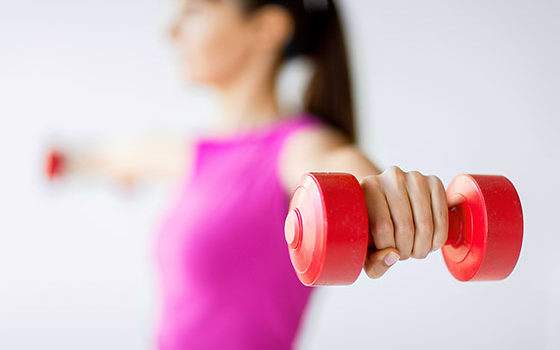Keeping your goals in sight and maintaining healthy life habits require discipline and determination.
Don’t be afraid of failure; you will reach your goals and set even bigger ones!
Getting in Shape with a Weight Training Program
Each workout program includes five exercises that target main muscle groups. Focusing on certain muscles only creates muscle imbalances and increases risk of injury.
Thanks to a colour code, you can see which muscle group is targeted by each exercise. It’s important to recognize which muscles are working when performing a movement and to know how to execute the movement safely and effectively.
Here are pictures and explanations for each of the exercises on the equipment free workout sheet (using only your body weight as resistance).
SQUAT
Place feet parallel about hip width apart and stabilize core by contracting your abdominal muscles. Bend knees to a 90 degree angle; then lift back to starting position.
Careful: Keep knees above toes.
HIP EXTENSIONS
Lie on your back, place arms along each side, and bend knees. Lift hips to form a straight line along your core, buttocks and thighs. While controlling your movements, slowly lift and lower hips.
KNEELING PUSHUPS
Rest knees on the ground with hands placed in front directly beneath shoulders. Stabilize core by contracting abdominal muscles.
Important: Make sure to execute each movement and to handle all equipment safely. Respect your limits since exhaustion increases risk of injury.
Lower until your elbows form a 90 degree angle; then contract muscles to return to starting position.
Careful: Don’t lock elbows at the end of the movement.
ALTERNATING SUPERMAN
Lie down flat on your stomach with arms stretched out above your head. Gently lift one arm and the opposing leg and hold for two seconds. Repeat with the opposite arm and leg.
Careful: Keep head aligned to relieve any pressure in the neck area.
SITUPS
Lie on your back and bend knees to 90 degrees. Place hands on each side of your head (or place arms along your body) and lift upper body until you feel some strain.
Careful: Keep hips neutral.
SIMPLE WORKOUT SHEET EXPLANATIONS
With the colour code you can see which muscle region is targeted by the exercise you are performing.
Sets: Number of times the series of reps are executed before rest.
Repetitions: Number of times the exercise or movement must be performed per set.
Pace: Execution rhythm of a repetition indicated in seconds using three numbers (for example, 3-0-3), where the first number indicates the time it takes for the “go” phase, the second number, how long to hold the position, and the third number, the time to get back to the exercise’s starting position.
Between-set rest: Length of rest time between sets, indicated in seconds.
Important
Write down the date of each workout. This way you can stay objective about your consistency.
GO AHEAD. TAKE A WALK!
Once a week – 20 min: Good for your morale!
Twice a week – from 10 to 20 min: Better sleep, reduces stress and anxiety.
Three times a week – from 30 to 40 min: Better shape, feeling of well-being and vitality.
From three to five times a week – 1 hour: Protects against cardiovascular diseases and diabetes.
COUNTING STEPS!
The average steps you take per day are a good indicator of your level of physical activity.
According to Kino-Québec, lifestyle can be determined based on the number of steps taken per day.
4,999 steps and less per day: Sedentary lifestyle
Between 5,000 and 7,499 steps per day: Mildly active lifestyle
Between 7,500 and 9,999 steps per day: Moderately active lifestyle
Between 10,000 to 12,499 steps per day: Active lifestyle
12,500 and more steps per day: Very active lifestyle
To know the usual number of steps you take in a day, carry a pedometer for a few days and note the results.
Pedometer
This little instrument serves to record the number of steps taken. It may be the trigger you need to get you walking every day, or just about…
You can find pedometers in sports stores or department stores at an affordable price.
Trainer tips
Plan your schedule today for upcoming weeks according to your exercise priorities. It just needs to become a habit…
These are important appointments you have with yourself. Don’t miss them!
Sophie Mc Greevy
Trainer
Trending Now —

